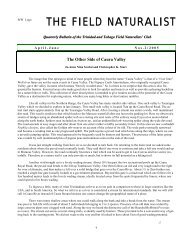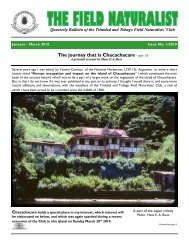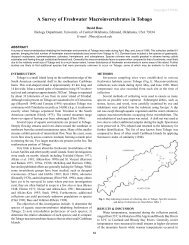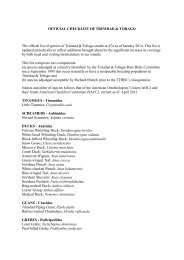Vol 1 - The Trinidad and Tobago Field Naturalists' Club
Vol 1 - The Trinidad and Tobago Field Naturalists' Club
Vol 1 - The Trinidad and Tobago Field Naturalists' Club
You also want an ePaper? Increase the reach of your titles
YUMPU automatically turns print PDFs into web optimized ePapers that Google loves.
Page 23 THE FIELD NATURALIST Issue No. 1/2013nies grow <strong>and</strong> mature at an accelerated pace.This is consistent with the hypothesis thatdaughters who remain on the nest as workersare making an investment that will pay offmuch better than if they left to nest on theirown.BibliographyRoss, K.G. & R.W. Matthews (eds.) 1990. <strong>The</strong>Social Biology of Wasps. Ithaca: Cornell Univ.Press 678 pp. See chapter on Polistes byH.K. Reeve.Starr, C.K. 1990. Holding the fort: Colonydefense in some primitively social wasps. Pp.421-63 in: D.L. Evans & J.O. Schmidt (eds.),Insect Defenses. Albany: SUNY Press.(www.ckstarr.net/cks/1990-DEFENSE.pdf )Starr, C.K. & A.W. Hook 2003. <strong>The</strong> aculeateHymenoptera of <strong>Trinidad</strong>, West Indies. Occ.Pap. Dep't Life Sci. Univ. West Indies (12):1-31. (Revised version at www.ckstarr.net/aculeates.pdf )A PARAGRAPH NOTED IN PASSINGChristopher K. StarrOccasionally in natural-history books <strong>and</strong>traveler's tales, I come upon remarks about<strong>Trinidad</strong> or <strong>Tobago</strong> that interest me. <strong>The</strong>american herpetologist <strong>and</strong> museum directorThomas Barbour (1884-1946) spent a greatdeal of time in the West Indies, especiallyCuba <strong>and</strong> the Bahamas, with quick visits tomany of the other isl<strong>and</strong>s. In his autobiography,Barbour (1943:127) had this oneparagraphcomment about a founding memberof the <strong>Trinidad</strong> <strong>Field</strong> <strong>Naturalists'</strong> <strong>Club</strong> <strong>and</strong>the endemic golden tree frog:"Our visit to Port-of-Spain, <strong>Trinidad</strong>, was agreat event, for I met then for the first timeFred Urich, with whom I had correspondedfor years. Someone had just brought him aliving tiny frog of the genus Amphodus, hithertounknown from <strong>Trinidad</strong>, a lovely little goldenyellowcreature, tiny but with eyes like jewels.This is found in bromeliaceous plants in thehighest l<strong>and</strong>s of the isl<strong>and</strong>, <strong>and</strong> he generouslygave it to me to take back to Cambridge. Hewas always doing things of this sort. I visitedhim again several years later in his home outsidePort-of-Spain, <strong>and</strong> was saddened later onwhen the news came of his death."<strong>The</strong> <strong>Trinidad</strong> <strong>Field</strong> <strong>Naturalists'</strong> <strong>Club</strong>, forerunnerof the present <strong>Trinidad</strong> <strong>and</strong> <strong>Tobago</strong> <strong>Field</strong>Naturalists’ <strong>Club</strong> was founded in 1891 byeight men (Carr 1991-1992). <strong>The</strong> 1991-1992issue of the Living World has biographicalsketches of five of these, but Friedrick WilliamUrich is not among them. Most of the verysparse biographical information about thisgovernment entomologist (as far as I know)was published by Carr (1991-1992) <strong>and</strong> Boos(2001:16-19).(Continued on page 27)








